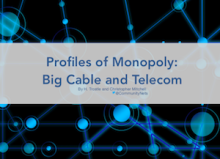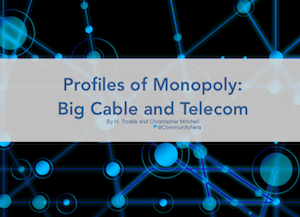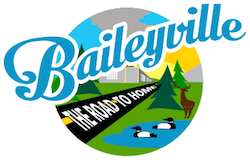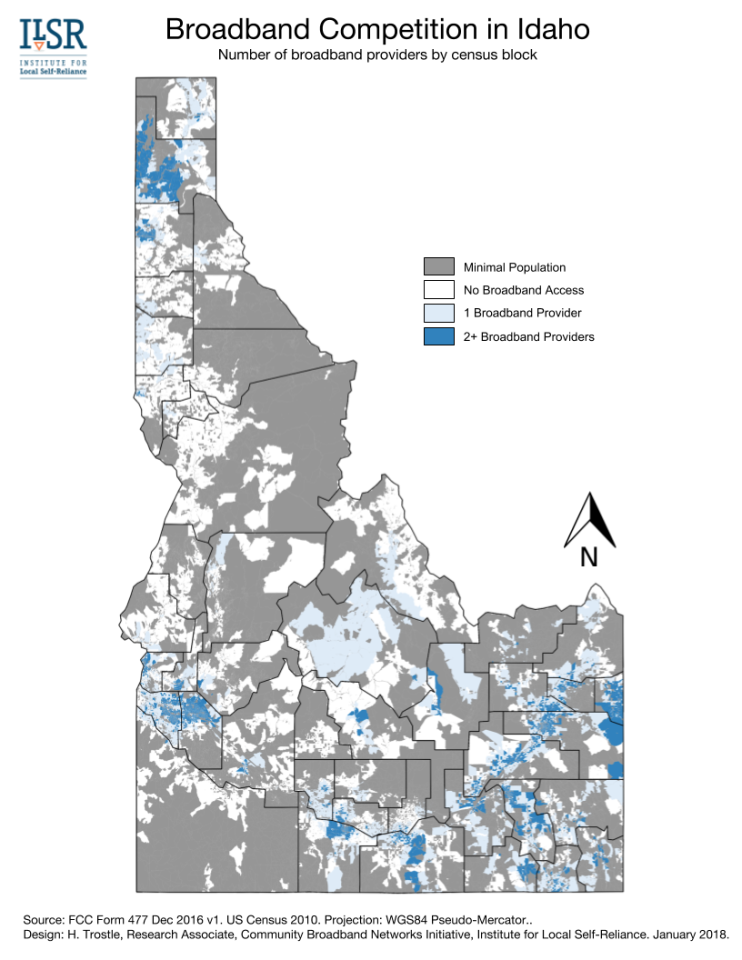
Fast, affordable Internet access for all.

It’s no secret that the Federal Communications Commission’s (FCC’s) broadband data is unreliable. Many people, including U.S. Senators, have pointed out how federal data collection methods overstate connectivity across the country. Rochester, Minnesota, is no exception. In this policy brief, we highlight the gulf between FCC broadband data for Rochester and what’s actually available to residents by examining local competition.
Download the policy brief Broadband Competition in the Rochester Region: Reality vs Federal Statistics here.
What’s Going On in Rochester
The city, home to the world-famous Mayo Clinic, had previously considered building a municipal network, but the idea was dropped, in part because of the incorrect perception that enough competition already exists between Internet service providers. Our analysis and the corresponding maps reveal that broadband competition in the region is more limited than many realize.
Shortcomings of FCC Data
As we’ve covered before, the FCC collects data by census block, which incorrectly inflates broadband access and competition data. Internet service providers self-report and describe an entire block as “served” even if they can only connect one address in that census block.
We describe the problems with self-reporting in the policy brief:
“Large, de facto monopoly providers have incentives to overstate their coverage and territory to hide the unreliable and slow nature of their service in many communities. Small providers often have trouble completing the FCC Form 477. . . Larger providers have plenty of staff to handle the form and seem to benefit the most from its flaws, as this data is often used to determine whether government programs should invest additional funds into an area, often by a competitive grant program. Areas that appear to be well covered will not result in more investment, leaving the incumbent providers without fear of competition.”
Lobbyists from the cable and telecom industry succeeded in using the legislature to firm up their rural Massachusetts monopolies this session. Communities that rely on state funds for local publicly owned broadband infrastructure projects now face restrictions on the reach of their high-speed networks.
A Long Trip Through the Legislature
Governor Charlie Baker’s economic development bill includes a provision designating funding for the Massachusetts Broadband Institute (MBI) and the Executive Office of Housing & Economic Development for broadband deployment. The agencies distribute the funds to various communities where residents and businesses plan to improve their local connectivity. Approximately 20 towns have decided to invest in publicly owned Internet infrastructure, including Alford, Otis, and Mount Washington, to name a few. Others are taking offers from Comcast and Charter, which will build out networks to more premises with state funding.
Many of the rural communities who are going with the publicly owned option want to connect households and establishments within the town proper, but also what they describe as “edge” properties — those beyond town limits but have no other choice for broadband. Edge properties in western Massachusetts typically don’t have access to anything better than expensive and unreliable satellite or dial-up. Often, there are only a few “edge” properties in each community, but neighbors don’t want to leave anyone behind.

For years, national cable and telecom companies have complained that they work in a tough industry because “there’s too much broadband competition.” Such a subjective statement has created confusion among subscribers, policy makers, and elected officials. Many people, especially those in rural areas, have little or no choice. We wanted to dive deeper into the realities of their claim, so we decided to look at the data and map out what the large carriers offer and where they offer it. In order to share our findings with policy makers, local elected officials, and the general public, we’ve created a report that includes series of maps to illustrate our findings and our analysis, Profiles of Monopoly: Big Cable and Telecom.
Choice, Data, the FCC
In this analysis, we examined Form 477 Data from ISPs and submitted to the FCC. While the data paints a grim picture of where competition truly exists, those who read the report should remember that Form 477 Data breaks down information into census blocks. As a result, the Form 477 overstates broadband service availability and the size of coverage areas. With this in mind, we believe the reality on the ground is even worse than what FCC data shows.
In the report, we shared our thoughts on the data from the FCC:
We have deep hesitations about using this data because of its many inaccuracies, but there is no other feasible option. In any event, this provides a conservative baseline for the problems in the market - though we believe the true level of competition is worse than this analysis shows, neither is tolerable in a country that claims to support a market-driven solution for supplying broadband Internet access.
Important Findings

If you haven’t already taken a look at our most recent report, now is your chance to get some insight before you download it and dive in. Profiles of Monopoly: Big Cable and Telecom, written by our Hannah Trostle, recently left ILSR to attend grad school, and Christopher Mitchell, transforms FCC Form 477 data into a series of maps that reveal a sad state of competition in the U.S. broadband market. For episode 317 of the podcast, Hannah and Christopher discuss the report and the main findings.
Hannah and Christopher provide more insight into the main findings of the report, which analyzes where competition exists and where large national providers fail to invest. The result ultimately creates densely populated areas with more competition for broadband (as defined by the FCC) than rural areas. Due to their de facto monopolies, the top national providers capture huge segments of the population.
Hannah and Christopher also talk about the quality of the Form 477 data and the need for better benchmarks, we learn about why Hannah and Christopher felt that it was time to take the data and turn it into a visual story. You’ll learn more about their methodology in developing the maps and their analysis. Hannah, who created the maps that make the foundation of the report, shares some of the surprises she discovered. The two talk about the Connect America Fund and the policies behind the program and how the results have aggravated lack of broadband in rural America and how cooperatives are picking up the slack where big corporate ISPs are failing rural America.
 If you want to learn more about how cooperatives are running circles around the big ISPs in rural areas, download our 2017 report, Cooperatives Fiberize Rural America: A Trusted Model for the Internet Era.
If you want to learn more about how cooperatives are running circles around the big ISPs in rural areas, download our 2017 report, Cooperatives Fiberize Rural America: A Trusted Model for the Internet Era.
This show is 37 minutes long and can be played on this page or via Apple Podcasts or the tool of your choice using this feed.
Transcript below.
We want your feedback and suggestions for the show-please e-mail us or leave a comment below.
Listen to other episodes here or view all episodes in our index. See other podcasts from the Institute for Local Self-Reliance here.
Thanks to Arne Huseby for the music. The song is Warm Duck Shuffle and is licensed under a Creative Commons Attribution (3.0) license.
For years, national cable and telecom companies have complained that they work in a tough industry because “there’s too much broadband competition.” Such a subjective statement has created confusion among subscribers, policy makers, and elected officials. Many people, especially those in rural areas, have little or no choice. We wanted to dive deeper into the realities of their claim, so we decided to look at the data and map out what the large carriers offer and where they offer it. In order to share our findings with policy makers, local elected officials, and the general public, we’ve created a report that includes series of maps to illustrate our findings and our analysis, Profiles of Monopoly: Big Cable and Telecom.
Choice: The Ultimate Prize
Whether it’s a brand of breakfast cereal, a model of car, or an Internet Service Provider (ISP), those who purchase a good or service know that when they have more options, the options they have are better. The FCC defines "broadband" as connectivity that provides speeds of at least 25 Megabits per second (Mbps) download and 3 Mbps upload; our report fouces on service where ISPs claim to offer this minimum threshold.
When it comes to ISPs, subscribers often have a faux choice between unequal services, such as one telephone company offering slow DSL and one cable company that offers faster cable Internet access. People in rural America often have even slimmer options because cable ISPs don’t provide broadband in less populated rural areas. In other words, the market has spoken and the market is broken.
In June, the city of Fairlawn and the Medina County Fiber Network in Ohio recently announced that they would soon begin working together, which will expand FairlawnGig, the city's municipal network. The collaboration will boost connectivity in the region for residents and provide more options for businesses in Akron and surrounding communities.
Fairlawn Full of Fiber
Deputy Director of Public Service Ernie Staten told us that when city leaders commenced the FairlawnGig project, they promised the community that they would first build out the the entire community of 7,500 residents. They achieved their goal in May and now have a 47 percent take rate in the city. The strong numbers indicate Fairlawn’s intense need for better services than incumbents were providing.
Staten told us that, in completing the deployment in Fairlawn, the city’s infrastructure now has a solid north-south presence. By leasing capacity on the Medina County Fiber Network (MCFN), FairlawnGig can expand in an east-west direction.
Potential commercial subscribers in Akron, east of Fairlawn, have already reached out to FairlawnGig offices, seeking more information. Staten notes that, while businesses in Akron have had access to connectivity from incumbents Spectrum and AT&T, prices are high and services are limited. FairlawnGig via the MCFN will be able to offer more options. Businesses will have access to services such as dark fiber connections, cloud services, data transport, and connections of up to 100 gigabits per second. Staten also believes that local businesses want the personal service and accountability that comes with a local provider.
Staten says that residents who live in the more rural areas west of town have also contacted FairlawnGig to find out more. FairlawnGig Fiber-to-the-Home (FTTH) gigabit service costs $75 per month or residents can opt for a 300 Megabits per second (Mbps) connection at $55 per month. Ten gigabit service for residential premises is also available and all connections are symmetrical. Voice services are also available; residents can sign up for $25 per month and receive two lines. FairlawnGig doesn’t offer video service, but makes resources available to help subscribers learn how to cut the cord to access video content.
A new video from Foresite Group describes the benefits and potentials of publicly owned open access networks. The company describes how a hypothetical rural town could use an open access network to provide better connectivity for residents and businesses and develop a revenue stream.
Check out this short video and take a few minutes to review our resources on publicly owned open access networks.
Municipal Owned Open Access Networks from Foresite Group, Inc. on Vimeo.
Nestled along the south eastern border of Maine are Baileyville and Calais. As rural communities situated next to Canada in the state's "Downeast" region, neither town is on a list of infrastructure upgrades from incumbents. With an aging population, a need to consider their economic future, and no hope of help from big national ISPs, Baileyville and Calais are joining forces and developing their own publicly owned broadband utility.
Baileyville and Calais
There are about 3,000 residents in Calais (pronounced "Kal-iss") and 1,500 in Baileyville, but according to Julie Jordan, Director of Downeast Economic Development Corporation (DEDC), many of those residents are aging and younger people find little reason to stay or relocate in Washington County. The community recognizes that they need to draw in new industries and jobs that will attract young families to keep the towns from fading off the map.
Most of the residents in the region must rely on slow DSL from Consolidated Communications (formerly FairPoint), while a few have access to cable from Spectrum (formerly Time Warner Cable); expensive and unreliable satellite is also an option and there's some limited fixed wireless coverage in the area. A few larger businesses that require fiber optic connectivity can find a way to have it installed, but Julie tells us that it's incredibly expensive in the area and most can't afford the high rates for fiber.
Economic Development Driven
 Organized in 2015, the nonprofit DEDC came together with the focus on recruiting new businesses to the area and to support existing businesses. As DEDC quickly discovered, unless the region could offer high-speed, reliable Internet infrastructure, attracting new businesses and helping existing businesses expand would be extremely difficult. They also determined that new families would not be interested in Baileyville or Calais without high-quality connectivity. "It was a no-brainer," says Julie, "you have to go fiber."
Organized in 2015, the nonprofit DEDC came together with the focus on recruiting new businesses to the area and to support existing businesses. As DEDC quickly discovered, unless the region could offer high-speed, reliable Internet infrastructure, attracting new businesses and helping existing businesses expand would be extremely difficult. They also determined that new families would not be interested in Baileyville or Calais without high-quality connectivity. "It was a no-brainer," says Julie, "you have to go fiber."

Deploying, maintaining, and operating a wireless network is easy, right? You just put up your equipment, sign up subscribers, and start raking in the dough, right? Not even close, says Travis Carter, one of the co-founders of US Internet and our guest for episode 301 of the Community Broadband Bits podcast. He should know -- he's deployed both wireless and fiber networks in Minneapolis.
In this episode, we get an update on US Internet’s progress on its fiber deployment. Travis also compares what it’s like to own, maintain, and operate each type of network. There are pros and cons of each and each is better suited for different environments and situations.
Travis and Christopher also talk about some of the marketing approaches that US Internet use after being in business for several years and determining what works in the Minneapolis market. He describes how a local company can compete against the big national ISPs by giving subscribers a good product, maintaining good customer service, and keeping an eye on long-term goals.
Learn more about US Internet in episode 194 of the Community Broadband Bits podcast.
This show is 34 minutes long and can be played on this page or via Apple Podcasts or the tool of your choice using this feed.
Transcript below.
We want your feedback and suggestions for the show-please e-mail us or leave a comment below.
Listen to other episodes here or view all episodes in our index. See other podcasts from the Institute for Local Self-Reliance here.
Thanks to Arne Huseby for the music. The song is Warm Duck Shuffle and is licensed under a Creative Commons Attribution (3.0) license.
Like many other states, connectivity across Idaho is unequally distributed. Urban areas may have a choice of one or two broadband providers while many rural areas have no options whatsoever. We have compiled the latest data from December 2016 into a map to highlight competition and show these disparities.
According to the Federal Communications Commission's (FCC) 2018 Broadband Progress Report, 98 percent of urban areas and 68 percent of rural areas in Idaho have broadband service, defined by the FCC as 25 Megabits per second (Mbps) downstream and 3 Mbps upstream. While about 1 million people in Idaho have access to two or more options, nearly half a million people are not nearly as lucky. Approximately 327 thousand of the state's 1.683 million people have only one option for broadband service, and 169 thousand still do not have access to broadband. This, however, is actually a best-case scenario.

Failures In Broadband Data
These statistics and this map, like most broadband data, rely on FCC Form 477. Internet Service Providers (ISPs) complete the form explaining which census blocks they serve or could serve. Census blocks are the smallest unit of measurement for the U.S. Census, and they vary in size. Rural census blocks often cover more land mass than urban areas. ISPs need only be able to offer service to one person in a census block in order to claim the entire census block. This can lead to an overstatement of how many people are actually served. The FCC launched an interactive map with this data, and FCC Commissioner Jessica Rosenworcel has invited people to submit corrections to broadbandfail@fcc.gov.